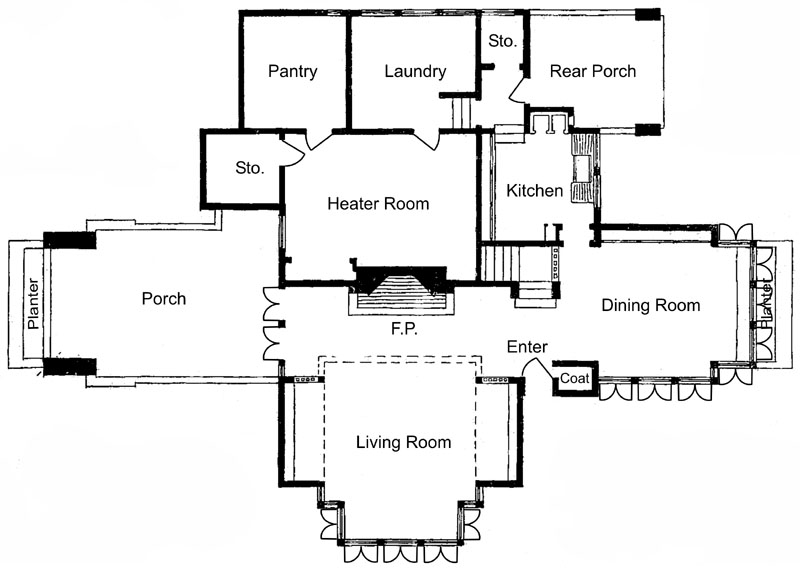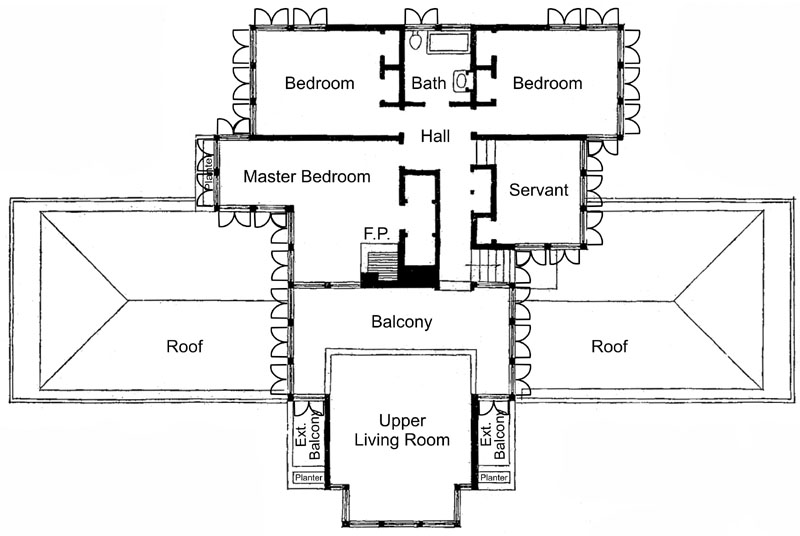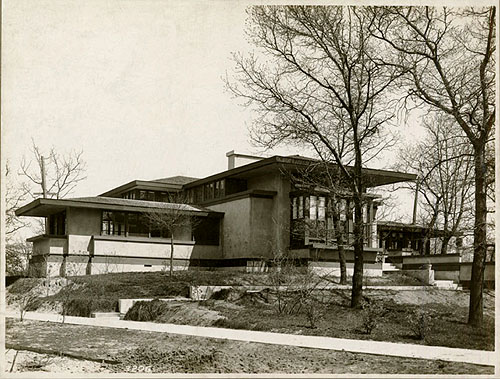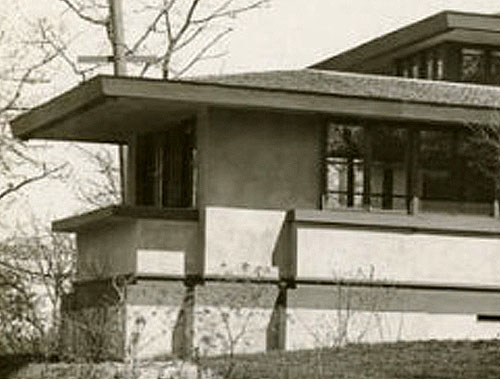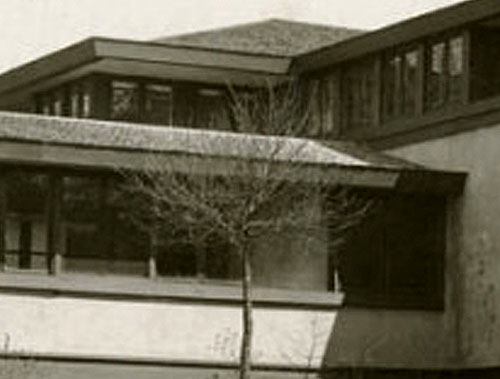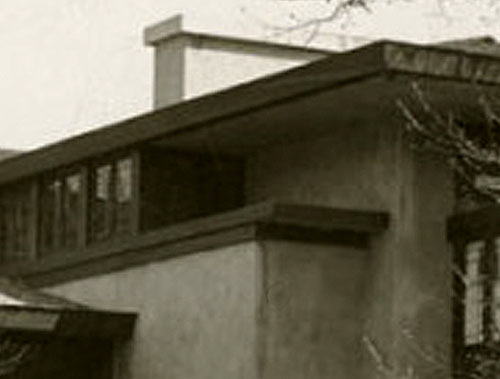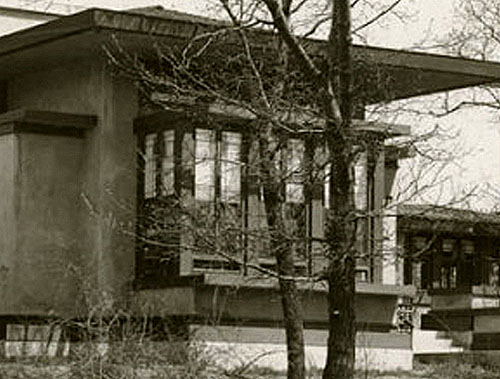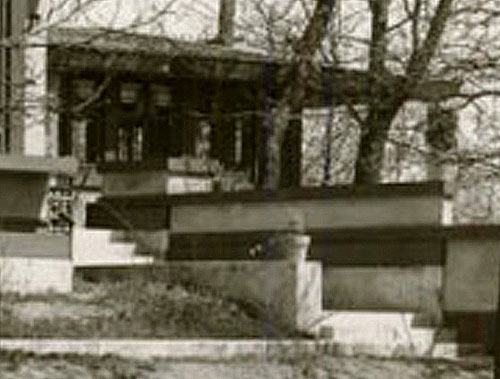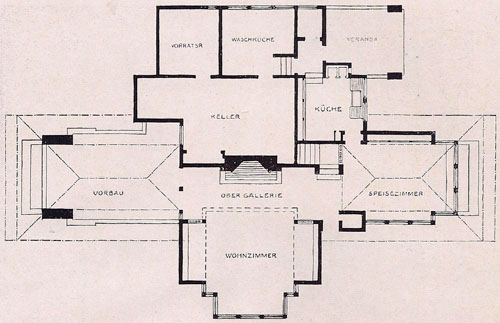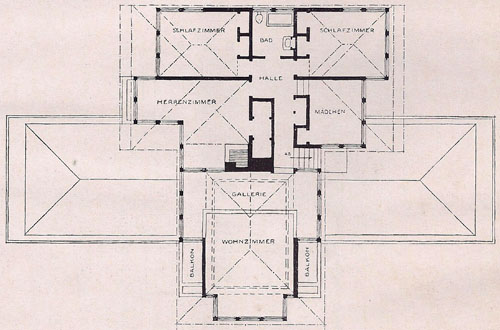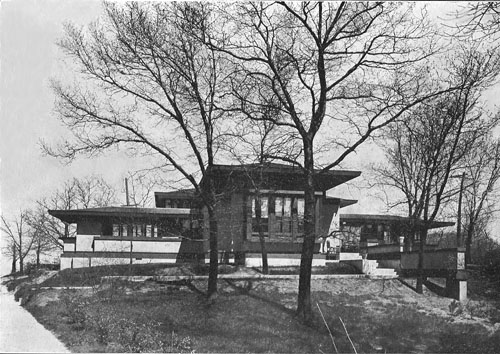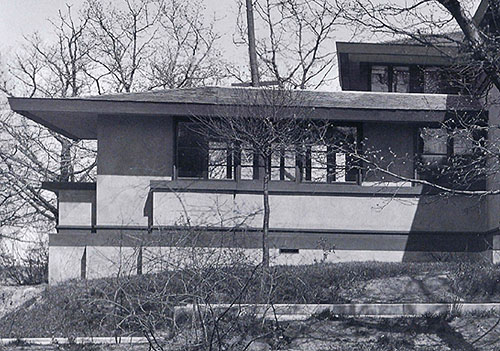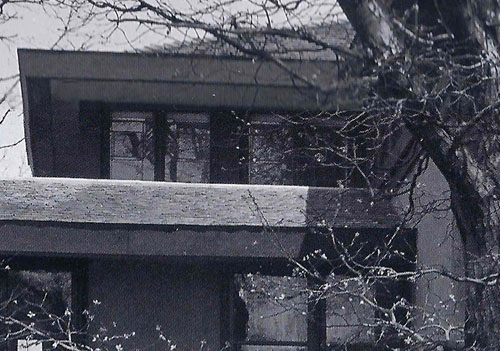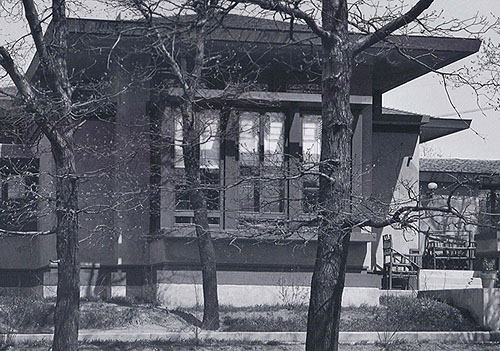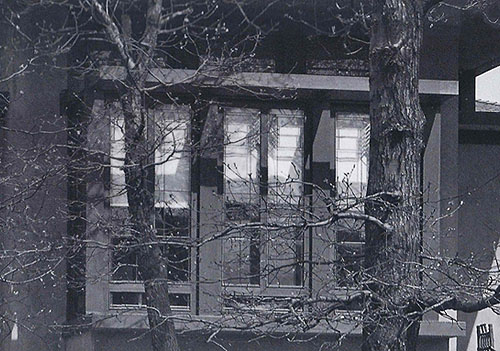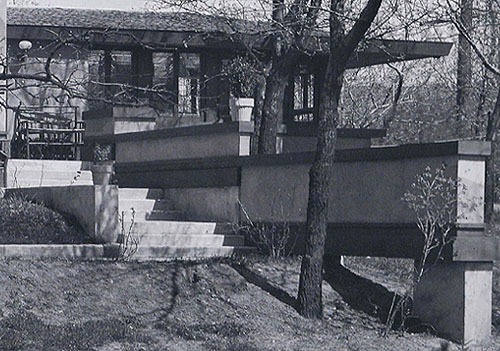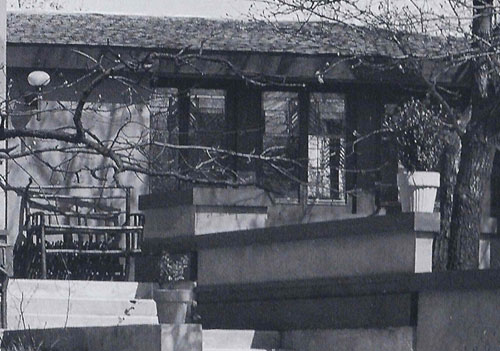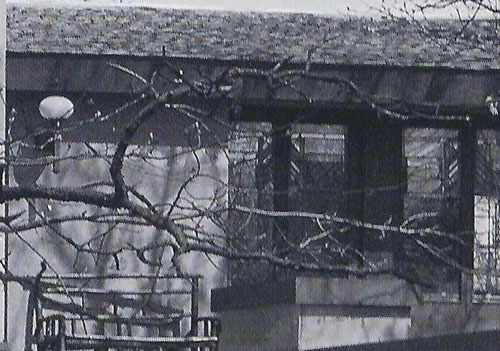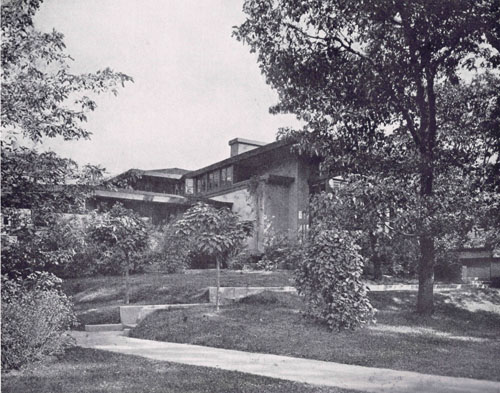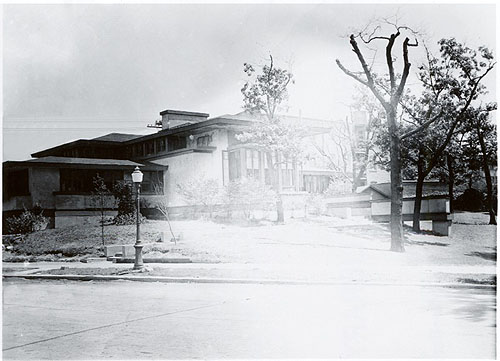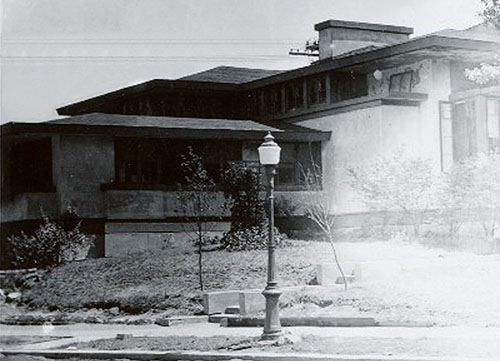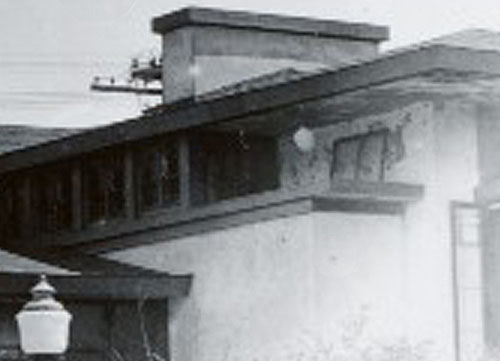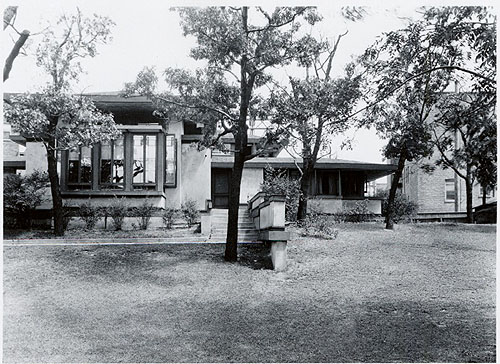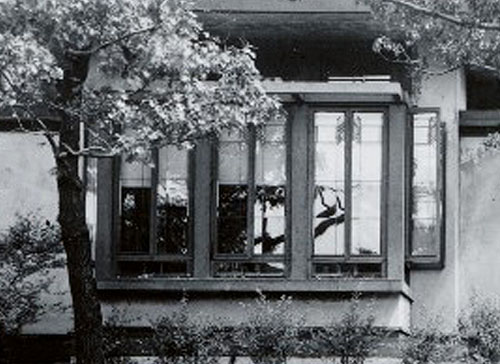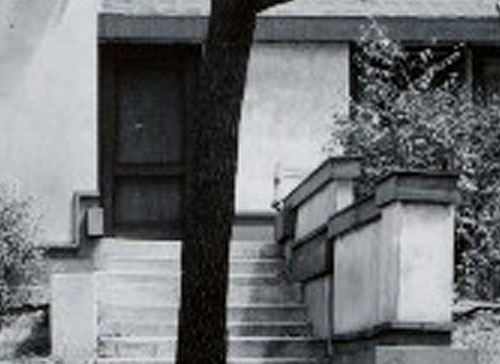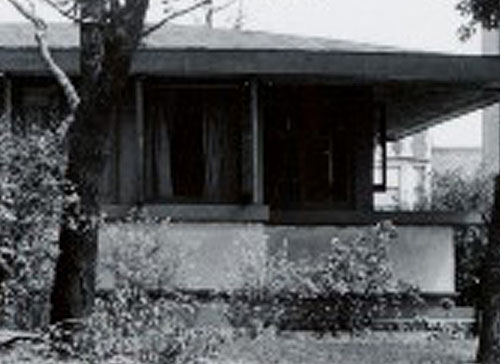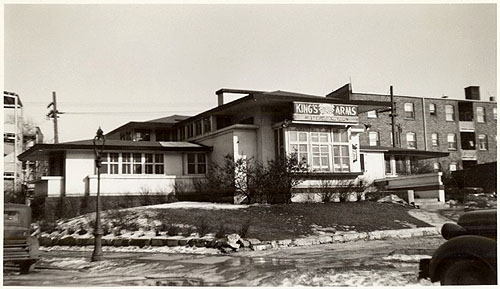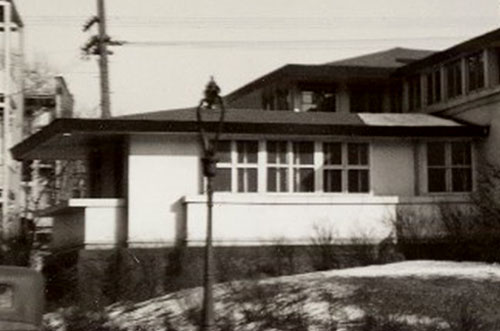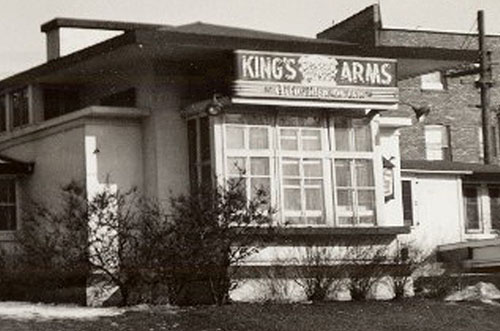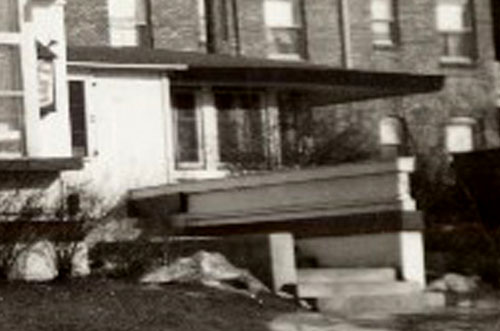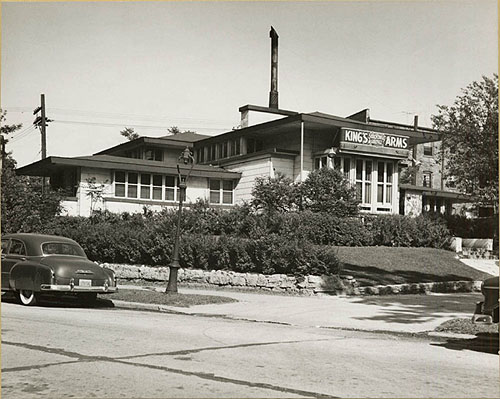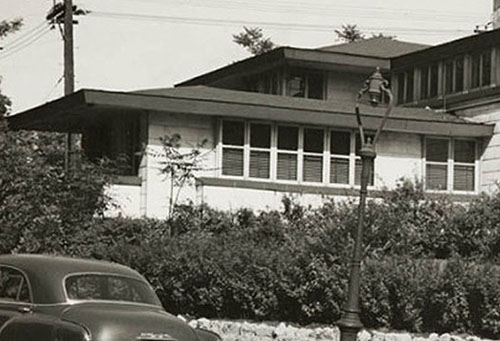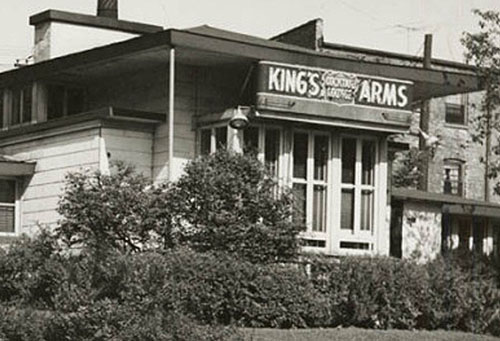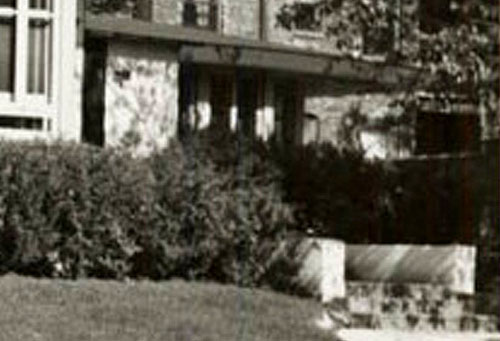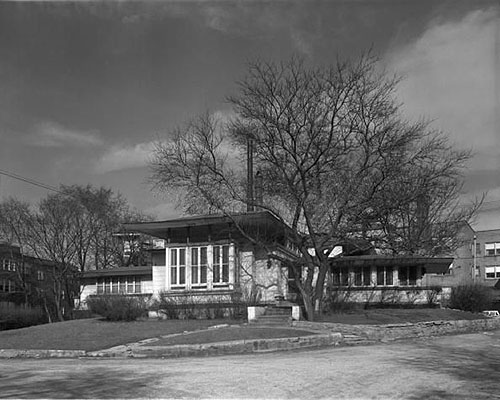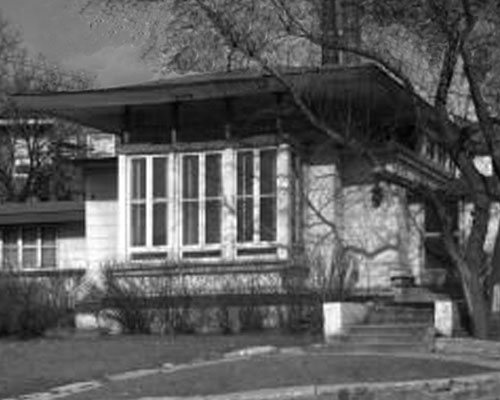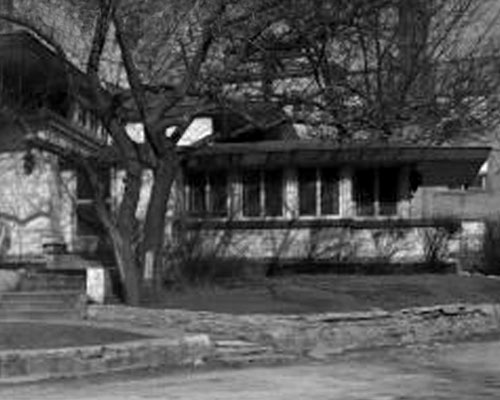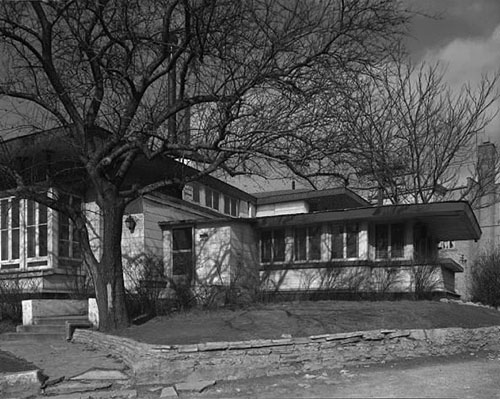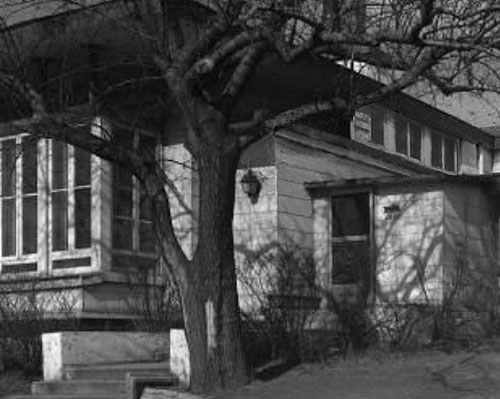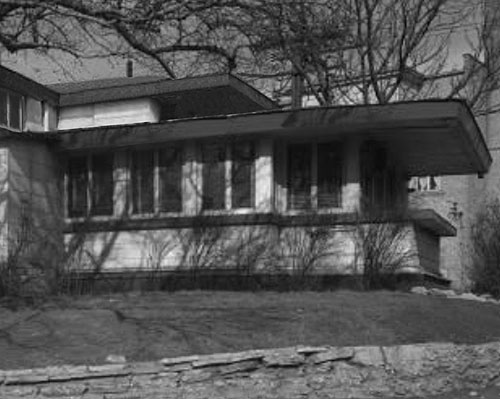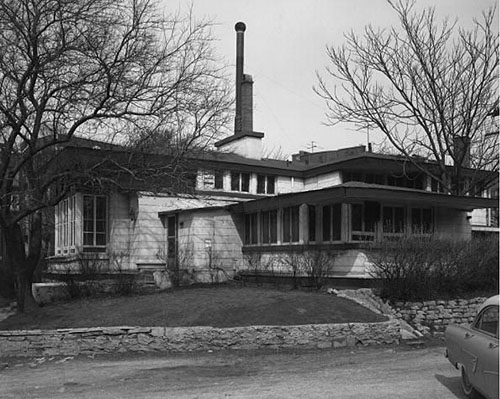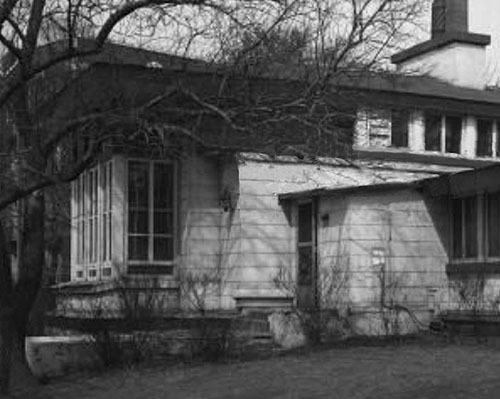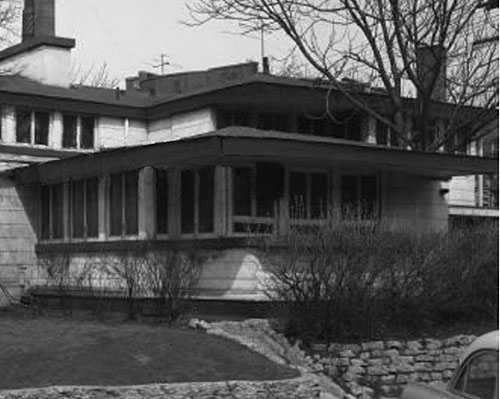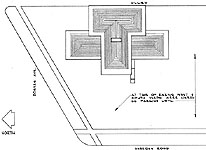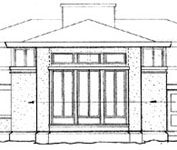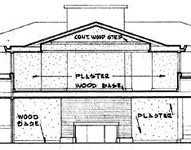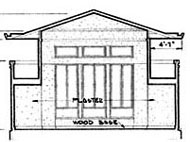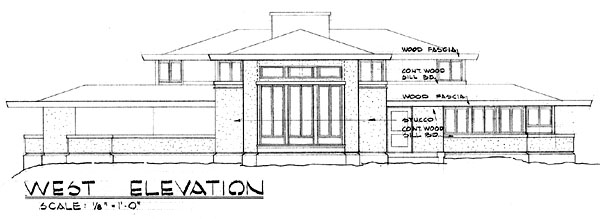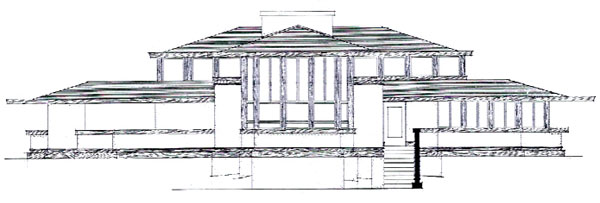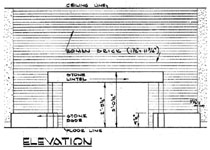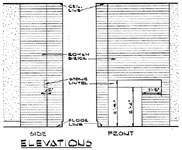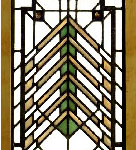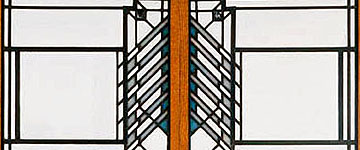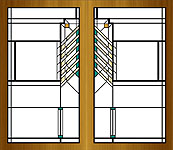- Wright Studies
Oscar M. and Katherine B. Steffens Residence, Chicago (1909 - S.153)
Introduction Floor Plan Ausgeführte Bauten (1911) Sonderheft (1911) Wendingen 1925 Gilman Lane c1930 Grant Carpenter Manson c1940 John Gordon Replinger c1950 Hedrich Blessing 1963 HABS 1963 Elevations 1963 Fireplaces 1963 Windows (Sheet 6) Books & Articles Introduction Frank Lloyd Wright chose to include one photograph of the Steffens residence and also the floor plan in "Frank Lloyd Wright, Ausgeführte Bauten" (Executed Buildings), 1911. That same year he published a different photograph in "Frank Lloyd Wright, Chicago" (Sonderheft), 1911. But one year earlier he had not included a drawing of the residence in "Ausgeführte Bauten und Entwürfe von Frank Lloyd Wright".
The Steffens Residence is a smaller version of Wright's Prairie styled homes and has been compared in design to the earlier Isabel Roberts Residence (1908 - S.150) in Oak Park. Although the home was built on a ridge about a block from Lake Michigan in the Birchwood neighborhood, Wright faced the home looking West, away from the lake, leaving few windows on the first floor faced the lake. The bedrooms on the second floor were the only rooms that enjoyed a view of the lake.
Very little information can be found concerning the Steffens or their Frank Lloyd Wright home. According to Cook County records, the property was purchased by Katherine B. Steffens in August 1908. There is no indication why her husband, Oscar M. Steffens was not included on the deed. He was a wealthy business man, and might have left the responsibilities of all aspects of the home in the hands of his capable wife. If she was the one that was responsible for purchasing the property, she may have also been responsible for contacting Wright, or possibly contacting Wright on her husbands behalf.
According to the October 30, 1907 issue of the business journal Clay Record, it was reported that "The Illinois Granite Brick Co. has been incorporated... for the purpose of manufacturing brick. Capital $250,000. Incorporators Oscar M. Steffens, Joseph A. Grober and Arnold D. McMahon." That is the equivalent investment of nearly six million dollars today.
The January 30, 1908 issue of the Clay Record, reported that "The Illinois Granite Brick Co. has purchased 40 acres of sand in Michigan City, Ind. and will build a sand lime brick plant. Paul Fuchs is president, O. M. Steffens treasurer and Leo H. Pleins secretary. All are Chicago men." By April, 1908 train track were installed for hauling brick to Chicago. By September, 1908, construction began for the Illinois Granite Brick Co. brick plant to be built in Michigan City, Ind. Little else can be found concerning the lives of Oscar M. and Katherine B. Steffens.
Wright was most likely contacted just after the purchase of the property or in early 1909. The home was completed by the end of 1909. Many classic Prairie styled features were part of the Steffens' home. Broad overhangs, shallow hipped roof, central fireplace and rows of second story clerestory windows cement stereotypical prairie features. Like the Walter Davidson (1908 - S.149), Isabel Roberts and Frank Baker (1909 - S.151) Residences, the Steffens also included a one and a half story Living Room. But unlike the first three homes where the Living Room windows extended to the roofline, the Steffens Living Room windows stopped short and fell in line with the base of the upper clerestory windows.One questions that begs to be asked. Why was the home not constructed of brick?
There are no records to indicate why the Steffens would move from their home after just three years. The home was purchased by Otto C. Bach in August 1912.
Otto C. Bach was the first of two brothers to own a Wright home. Emil Bach (S.193) hired Wright to design a home in 1915.
Otto Carl Bach was born in Germany on January 18, 1872 to William and Katharina Bach. The Bach family immigrated to Chicago in 1881 when he was nine years old. He attended Bryant & Stratton Business Collage. On January 17, 1907 he married Louise Cora Gatter of Evanston, Illinois, who was born in 1887. She was twenty years old, fifteen years younger than her husband. They had two sons, Otto Carl, Jr., born in June 1909, and Robert W. Bach, born in 1912.
His father, William Bach started one of the first brick manufacturing plants in Chicago, having brought the skill with him from Germany. Carl began working for his father's company, the William Bach & Sons Co. in 1886. He becoming a stockholder in 1900. When his father William Bach, Sr. retired in 1905, Otto and his five brothers changed the name to the Bach Brick Co.
As a result of the many visits to his brother's Wright designed home, Emil Bach had to have one of his own. He purchased a lot just two blocks north of his brother's home on Sheridan Road. In 1915, during the middle of World War I, Wright designed the Emil Bach Residence.
Otto C. Bach past away on October 7, 1932 at 60 years of age, after living in his Wright designed home for twenty years. Birchwood, which had once been a scarcely populated neighborhood was now crowded and bustling. The city of Chicago exploded North with Sheridan Road becoming a major thoroughfare. For reasons unrecorded, Louise moved out of home after her husbands death, but retained ownership. Possibly more than a single mother could manage or afford. She rented the home, and for the next thirty years the King's Arms Restaurant abused was once was a beautifully designed Frank Lloyd Wright home. When Louise Bach past away, the home went to Otto C. Bach Jr. in December 1960. He continued to rent the property to the restaurant, but when approached by a developer, and with no real ties to the home, sold it to O. W. Howell Enterprises in January 1963. Three months later, and only a skeleton remaining of the home, it was laid to rest.
All that survived were a few of the windows. As legend has it, on April 6, 1963, Richard Nickel, the Chicago-born photographer was arrested for "saving" some Frank Lloyd Wright windows from the Oscar Steffens house, which was under demolition. The charges were dropped. According to Thomas Heinz others ended up installed in the Arkansas vacation home of a Chicago architect.
Over a hundred years later, like the Husser residence before it a nondescript apartment complex is located where the Steffens Residence once stood.
April 2012
Floor Plan
Floor plan for the First level. The Living Room windows were originally designed to run from floor to ceiling, but alterations created a bay, with the top lining up with the base of the upper clerestory windows. Spindled screens on either side of the Living Room added a measure of privacy. The exterior balcony lowered the ceiling on either side, creating a space with a space. With built-in seating, this feature is reminiscent of the Usonian Living Rooms Wright designed decades later. From the corner of Sheridan and Rogers, the entrance to the home was hidden. Upon entering the home when you turned left (North) and walked past the Living Room and centralized Fireplace, a double set of doors lead out to an enclosed covered porch, with a built-in Planter. The stairs across from the Entrance lead to the second floor. To the right (South) was the Dining Room. A spindled screens enclosed the stairway, adding a sense of privacy. As you pass through the Dining Room, you enter the Kitchen. Passing through the Kitchen allowed access to the utility rooms and the enclosed rear Porch. Stairs lead down to an enclosed Rear Porch, and additional stairs to the Utility rooms which were located behind the Fireplace. By lowering these rooms on the first floor, this allowed the roofline of the bedrooms upstairs to line up with the Living Room roof which was only a story and a half. Courtesy of "Frank Lloyd Wright, Ausgeführte Bauten (Executed Buildings)", 1911. Modified by Douglas M. Steiner, copyright 2012.
Floor plan for the Second level. As you reach the top of the stairs, turn left and you enter the Balcony which overlooks the Living Room. On either side of the balcony, doors lead out to an exterior Balcony with built-in Planters. Bedrooms and the Bath were reached by turning right at the top of the stairs. A row of art glass clerestory windows were recessed just beneath the roof line. Courtesy of "Frank Lloyd Wright, Ausgeführte Bauten (Executed Buildings)", 1911. Modified by Douglas M. Steiner, copyright 2012.
Frank Lloyd Wright, Ausgefuhrte Bauten (Executed Building), 1911
One year after Frank Lloyd Wright produced the "Ausgeführte Bauten und Entwürfe von Frank Lloyd Wright" (S.87), he wrote and produced "Frank Lloyd Wright, Ausgeführte Bauten" (Executed Buildings). All in German, it was published by Ernst Wasmuth A.-G., Berlin in 1911. Wright included one photograph (page 60) and the floor plan for the first and second floors. But the floor plans were miss labeled. The floor plans (page 61) labeled for the Steffens residence were actually those for the Evans residence (1908 - S.140) and vice versa. The Steffens floor plans are on page 85.
Frank Lloyd Wright, Chicago (Sonderheft), 1911
One year after Frank Lloyd Wright produced the "Ausgeführte Bauten und Entwürfe von Frank Lloyd Wright" (S.87), he wrote and produced "Frank Lloyd Wright, Ausgeführte Bauten" (Executed Buildings). All in German, it was published by Ernst Wasmuth A.-G., Berlin in 1911. That same year he published a different photograph in "Frank Lloyd Wright, Chicago" Verlegt bei Ernst Wasmuth A.-G., Berlin 1911. (8. Sonderheft der Architektur des XX. Jahrhunderts. #8 Special Edition of Architecture of the 20th Century.) It was also published by Ernst Wasmuth A.-G., Berlin. It was a second Version of "Frank Lloyd Wright Ausgefuhrte Bauten" (Ececited Buildings). The text is the same, but laid out differently. Some of the photos and Illustrations also differ. The cover states that "This German issue is for sale only in Europe." Wright included one photograph on page 51.
Wendingen Volume VII, Number 4, 1925
Wendingen, a Dutch art magazine, was published monthly between 1918 and 1931. Many of the 116 issues were edited and designed by Hendrik Theodorus Wijdeveld, a Dutch architect and designer. It was published for architects and interior designers by Amsterdam publisher Hooge Brug and was a mouthpiece for the architect association "Architectura et Amicitia", an Amsterdam-based society, which developed into the major representative of the Amsterdam School. H. Th. Wijdeveld was the chief editor.
Eight issues were devoted to Frank Lloyd Wright's work. The first was Volume IV, Number 11, 1921. The cover, designed by El Lissitzky, is considered to be one of his greatest compositions.
In 1925, a series of seven issues were published on thework of Wright, Volume VII, Numbers 3 - 9.
That year all seven issues were combined into a bound volume entitled "The Life Work of the American Architect: Frank Lloyd Wright", 1925, published by C.A. Mees Santpoort, Holland. In 1947 A. Kroch ordered 500 copies of the remaining unbound stock and published the volume in 1948.
In 1965, Horizon Press republished a boxed version entitled "The Work of Frank Lloyd Wright, The Great Wendingen Edition"
For more information on the Wendingen publications see "Wendingen, A Journal for the Arts 1918 - 1932".
Wright included one photograph of the Steffens home in Volume VII, Numbers 4, page 52.
Viewed from the Northwest, from Rogers Avenue. Although published in 1925, this was probably photographed circa 1915, judging by the maturity of the landscaping. Courtesy of Wendingen.
Gilman Lane Circa 1930
Gilman Lane photographed building in the Chicago area including many of Wright’s work. Upon his death in 1961, Lane donated his collection of over 700 photographs to the Oak Park Public Library. According to William Jerousek, Librarian at the OPPL, Lane was an industrial arts teacher at the Oak Park-River Forest High School from 1923 to 1957.
Whether a one-time professional, part time freelance, or "amateur", the results were anything but amateur. He left an early record of over 150 Wright buildings. In the seminal Biography of Wright's Work by Henry-Russell Hitchcock, "The Nature of Materials", Hitchcock credits Henry Fuermann and Sons, and "another important group of photographs taken by Gilman Lane...who has been photographing Wright's work for many years, and who has taken many new photographs particularly for this book."
Lane began documenting Wright's work in the 1920s. There are two Lane photographs of the Steffens residence in the OPPL collection. Although a flare damages the first, it gives us a glimpse into the condition of the home. Street lamps have been installed. Most of the mature trees are either dead or dying. The North side of the home does not seem to be fairing as well as the South. The stucco finish on the covered Porch is discolored as is the upper balcony wall and soffit.
The home wasn't converted to a restaurant until 1933, so these two photographs were taken before then.
Grant Carpenter Manson, Circa 1940
Architectural historian Grant Carpenter Manson first met Mr. Wright in 1938. He had decided to make Wright the subject of his doctoral dissertation while at Harvard. He felt it essential to meet Wright and so in September he headed toward Spring Green from Massachusetts. Upon reaching Chicago, he placed a call to Spring Green and asked the operator “to put him through to Mr. Wright”. He heard his voice for the first time. Manson took photographs between 1937 and 1941 while researching for his doctoral dissertation titled “Frank Lloyd Wright's Work Before 1910". While a professor at the University of Pennsylvania, he elaborated his thesis and published his book “Frank Lloyd Wright to 1910: The First Golden Age" in 1958. Upon publication, Manson hand delivered a copy of the book to Wright in New York.
Mr. Manson gave the photographs and other materials to the library in July 1973. Grant Carpenter Manson (1904-1997).
Upon Otto C. Bach's death in 1932, Louise moved out after living in their Wright home for twenty years. She retained ownership of the home, and due to the expansion of the city, everincreasing apartment complexes in the neighborhood and its location on Sheridan Road, it became home to the King's Arms Restaurant for the next thirty years.
Most likely photographed around 1940 on a warm Winter or Spring day. Snow is melting and and clientele for the local apartment complexes are plentiful. Sandy Goldman, reminiscing about the Rogers Park Community wrote, the "...King’s Arms restaurant (great food; great bar) stood on a hill at the S.E corner..."
The exterior stucco has been freshly painted, as has the trim. Storm windows have been added to the covered Porch and Living Room. The front sidewalk that started at Rogers Avenue and passed in front of the Living Room to the Entrance, has been removed and the front yard has been paved. Restaurants must have a sign. but no care was taken to keep any continuity with the design of the home. A smaller sign has been added to the exterior wall to the right of the Living Room bay window. The landing at the top of the stairs has been enclosed.
John Gordon Replinger, Circa 1950
Hedrich Blessing, January 1, 1963
Ken Hedrich and Henry Blessing founded Hedrich Blessing in 1929. When Blessing left for Denver within the year, brother Ed Hedrich came in to manage the office. In 1931 brother Bill came on board as the first of hundreds of photographic assistants who would learn their craft at HB.
In 1937 Architectural Forum magazine commissioned Hedrich Blessing to photograph recent works of Frank Lloyd Wright. Kenmade several trips to Taliesin and formed another lifelong collaboration with Wright. Bill’s images of the Kaufman residence in Pennsylvania so captured the essence of Wright’s masterpiece that it reputedly inspired the name “Falling Water”.
These photographs were taken on January 1, 1963, just months before its destruction of the Oscar Steffens residence, to make room for an apartment complex.
1) Photographed just months before its destruction to make room for an apartment complex. The King’s Arms Restaurant, which occupied the facility for the past 30 years, has vacated the premises. Viewed from the Southwest, standing in the parking lot, which used to be the front yard. The covered Porch, now enclosed, is on the left, the Living Room in the center and Dining Room on the far right. The Entrance is to the right of the Living Room. The front yard has been paved. The exterior walls have been covered with asbestos shingles. Storm windows cover the Porch and Living Room windows. Wood beams can be seen above the Living Room Bay which were added to support the large restaurant sign that existed for 30 years. An apartment building on Eastlake Terrace can be seen in the background on the far right. Photographed on January 1, 1963 by Hedrich Blessing. 1A) The covered Porch, now enclosed, is on the far left, the Living Room in the center. The Entrance is to the right of the Living Room. The front yard has been paved. The exterior walls have been covered with asbestos shingles. Storm windows cover the Porch and Living Room windows. Wood beams can be seen above the Living Room Bay which were added to support the large restaurant sign that existed for 30 years. 1B) The Living Room is on the far left, the Dining Room on the far right. The Entrance is to the right of the Living Room. The front yard has been paved. The exterior walls have been covered with asbestos shingles. 2) Photographed just months before its destruction to make room for an apartment complex. The King’s Arms Restaurant, which occupied the facility for the past 30 years, has vacated the premises. Viewed from the Southwest, standing in the parking lot, which used to be the front yard. The Living Room is on the left, The enclosed Entrance was extended thirty years ago when the home was converted to a restaurant. The Dining Room is on the right. The upper level can be seen above the Entrance and Dining Room. The exterior walls have been covered with asbestos shingles. Storm windows cover Living Room and Dining Room windows. Wood beams can be seen above the Living Room Bay which were added to support the large restaurant sign that existed for 30 years. Photographed on January 1, 1963 by Hedrich Blessing. 2A) The Living Room is on the left, The enclosed Entrance was extended thirty years ago when the home was converted to a restaurant. The upper level can be seen above the Entrance. The exterior walls have been covered with asbestos shingles. Storm windows cover Living Room. Wood beams can be seen above the Living Room Bay which were added to support the large restaurant sign that existed for 30 years. 2B) The Entrance is to the left of the Dining Room. Built-in exterior planters extend below the windows on the right. The upper level can be seen above the Entrance and Dining Room. The exterior walls have been covered with asbestos shingles. Storm windows cover Dining Room windows. 3) Photographed just months before its destruction to make room for an apartment complex. The King’s Arms Restaurant, which occupied the facility for the past 30 years, has vacated the premises. Viewed from the South, standing in the parking lot, which used to be the side yard. The Living Room is on the left, The enclosed Entrance was extended thirty years ago when the home was converted to a restaurant. The Dining Room is on the right. A storage room, added by the restaurant, is visible just to the right of the third Dining Room window of the south wall. It extends out 4-5 feet and is about eight to nine feet long. The upper level can be seen above the Entrance and Dining Room. The exterior walls have been covered with asbestos shingles. Storm windows cover Living Room and Dining Room windows. Photographed on January 1, 1963 by Hedrich Blessing. 3A) Viewed from the South, standing in the parking lot, which used to be the side yard. The Living Room is on the left, The enclosed Entrance was extended thirty years ago when the home was converted to a restaurant. The Dining Room is on the right. The upper level can be seen above the Entrance and Dining Room. The exterior walls have been covered with asbestos shingles. Storm windows cover Living Room and Dining Room windows. 3B) The enclosed Entrance is on the far left. The Dining Room is in the center. A storage room, added by the restaurant, is visible just to the right of the third Dining Room window of the south wall. It extends out 4-5 feet and is about eight to nine feet long. The upper level can be seen above the Entrance and Dining Room. The exterior walls have been covered with asbestos shingles. Storm windows cover Dining Room windows.
HABS: Historic American Buildings Survey 1963
In April, 1963, just before the destruction of the Steffens Residence, architects R. Gardner and J. William Rudd recorded precise measurements for the National Park Service. These drawings, completed on April 4, 1964, along with the written description completed in September 1966, leave an invaluable record of the Oscar Steffens Residence. Included are six sheets of measured drawings and a five page report.
Located on the Southeast corner of Sheridan Road and Rogers Avenue, the home was set back against the alley, allowing a larger front and side yard... Continued...
HABS: Elevations (Sheet 4)
Comparing Wright's original elevations to the 1963 HABS allows us the opportunity to see alterations, many of which were completed during construction. It also gives details of finished construction materials, trim details, roof overhangs and windows sizes for all four sides. The Design of the Master Bedroom bay, hidden from view in existing photographs is exposed in... Continued...
HABS: Fireplaces (Sheets 2-3)
There were two fireplaces in the Steffens Residence. The large centralized Living Room Fireplace was similar in design to the Meyer May (1908 - S.148), Davidson (1908 - S.149), Roberts (1908 - S.150), Frank Baker (1909 - S.151) and many others designed during that time period with slight variations. The second was a corner Fireplace in the Master Bedroom. Both were faced in Roman Brick and like most of Wright's brickwork, more than likely the horizontal lines were racked, while the... Continued...
HABS: Windows (Sheet 6)
The Steffen art glass windows were asymmetrical in design, but when combined, were symmetrical, creating an inverted chevron shape. They were executed in clear glass and three colors. Wright specified Zinc cames in three widths. There were six standard sizes of windows, all opened outward. The Dining Room also contained a single window with a... Continued... Text and illustrations Copyright 2012, Douglas M. Steiner unless otherwise noted.
ITEMS RELATED TO THE STEFFENS RESIDENCE
"Frank Lloyd Wright, Ausgeführte Bauten", Wright, 1911, pages 60, 85. "Frank Lloyd Wright, Chicago" (Sonderheft), Wright, 1911, page 51. "Wendingen", Volume VII, No. 4, 1925, Wright, page 52. "The Life Work of the American Architect: Frank Lloyd Wright", 1925/1948, Wright, page 52. "The Work of Frank Lloyd Wright, The Great Wendingen Edition" 1965, Wright, page 52. "The Prairie School Tradition. The Prairie Archives of the Milwaukee Art Center", 1985, page 73. "Important American Arts & Crafts & Architectural Designs", Christie's, 1989, pages 110-111. "Frank Lloyd Wright Monograph 1907 -1913", Text: Pfeiffer, Bruce Brooks;
Edited and Photographed: Futagawa, Yukio, 1991, Pp 108-109."The Frank Lloyd Wright Companion", Storrer, 1993, Page 156. "Frank Lloyd Wright Glass Art", Heinz, 1994, page 143. "Lost Wright" Lind, 1996, Pages 39, 58-59. "Frank Lloyd Wright - Field Guide, Vol 2, MetroChicago", Heinz, 1997, pages 113. "Frank Lloyd Wright", McCarter, 1999, pages 92-93. "Light Screens: The Leaded Glass of Frank Lloyd Wright", Sloan, 2001, pages 106, 110-111. "Frank Lloyd Wright, Complete Works 1885-1916", Pfeiffer: Gossel, 2011, pages 366-367.
- Additional Wright Studies
- Adelman (S.344) Banff National Park Pavilion (S.170) Bitter Root Inn (S.145) Blair Residence (S.351) Blumberg Residence (Project)
Boomer Residence (1953 - S.361) Brandes Residence (S.350) Browne's Bookstore (S.141) Como Orchard Summer Colony (S.144)
Cooke Residence (1953) Copper Weed Urn & Weed Holder Disappearing City (1932) Elam Residence (S.336) "Eve of St. Agnes" (1896)
Feiman Residence (S.371) Frank L. Smith Bank (S.111) Gordon Residence (S.419) Griggs Residence (S.290) Hartford Resort (Project 1948)
Heller Residence (S.038) Henderson Residence (S.057) Hoffman Showroom (S.380) Horner Residence (S.142) "House Beautiful" 1896-98
Husser Residence (S.046) Imperial Hotel (S.194) Silverware and Monogram Japanese Print Stand (1908) Kalil Residence (S.387)
Lake Geneva Hotel (S.171) Lamp Cottage, Rocky Roost (S.021) Lockridge Medical Clinic (S.425) Lykes Residence (S.433)
Marden Residence (S.357) March Balloons Midway Gardens (S.180) Midway Gardens Dish (S.180) Nakoma Clubhouse
Nakoma Furniture Opus 497 Pebbles & Balch Remodel (S.131) Pilgrim Congregational Church (S.431) Loren B. Pope (S.268)
Roloson Rowhouse (S.026) Shavin Residence (S.339) Sixty Years Exhibition 1951-56 J. L. Smith Residence (1955) Steffens Residence (S.153)- Stohr Arcade (S.162) Stromquiest Residence (S.429) Sutton Residence (S.106) Teater Studio (S.352) Thurber Art Galleries (S.154)
- Tracy Residence (S.389) Trier Residence (S.398) Usonian Automatic Homes Williams (Way & Williams) (S.033)
Wyoming Valley School (S.401) Zimmerman Residence, (S.333)- Frank Lloyd Wright's First Published Article (1898)
- Photographic Chronology of Frank Lloyd Wright Portraits
"Frank Lloyd Wright's Nakoma Clubhouse & Sculptures." A comprehensive study of Wright’s Nakoma Clubhouse and the Nakoma and Nakomis Sculptures. Now Available. Limited Edition. More information.
HOME ARTIFACTS AUDIO BOOKS PERIODICALS PHOTOS POSTCARDS POSTERS STAMPS STUDIES ASSISTING ABOUT SEARCH
SEARCH WEB SITE To donate or pass on information, comments or questions: info@wrightlibrary.com ©Copyright 2001, 2014
